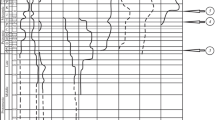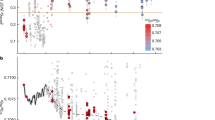Abstract
For marine carbonates, an overwhelming amount of information exists in a variety of specialized journals addressing marine geochemistry and carbon cycling, as well as in many books summarizing the state of knowledge on this topic. Therefore it would be far beyond the scope of this chapter to try to completely review what is known about marine calcareous sediments and their diagenesis. On the other hand, although intensively investigated since the previous century (e.g. Murray 1897), marine carbonates have gained increasing attention by marine biologists, geochemists, paleoceanographers and paleoclimatologists over the last three decades. Among other reasons this is because marine carbonates, together with the oceanic CO2-carbonic acid-system, act as a sink or source of carbon within the global carbon cycle which has become a key topic of investigation and modelling related to the role of the greenhouse gas CO in future global climate change.
Access this chapter
Tax calculation will be finalised at checkout
Purchases are for personal use only
Preview
Unable to display preview. Download preview PDF.
Similar content being viewed by others
References
Adler, M., Hensen, C. and Schulz, H.D., in press. Computer simulation of deep-sulfate reduction in sediments off the Amazon Fan. Geol. Rdsch.
Andersen, N.R. and Malahoff, A., 1977. The fate of fossil fuel C02 in the Oceans. Plenum Press, NY, 749 pp.
Archer, D.E., 1991. Modeling the calcite lysocline. Journal of Geological Research, 96: 17037–17050.
Archer, D. and Maier-Reimer, E., 1994. Effect of deep-sea sedimentary calcite preservation on atmospheric C02 concentration. Nature, 367: 260–263.
Archer, D.E., 1996a. An atlas of the distribution of calcium carbonate in sediments of the deep sea. Global Biochemical Cycles, 10: 159–174.
Archer, D.E., 1996b. A data-driven model of the global calcite lysocline. Global Biochemical Cycles, 10: 511–526.
Berelson, W.M., Hammond, D.E. and Cutter, G.A., 1990. In situ measurements of calcium carbonate dissolution rates in deep-sea sediments. Geochimica et Cosmochimica Acta, 54: 3013–3020.
Berelson, W.M., Hammond, D.E., McManus, J. and Kilgore, T.E., 1994. Dissolution kinetics of calcium carbonate in equatorial Pacific sediments. Global Biogeochemical Cycles, 8: 219–235.
Berger, W.H., 1976. Biogenic deep-sea sediments: Production, preservation and interpretation. In: Riley, J.P. and Chester, R. (eds) Chemical Oceanography, 5, Academic Press, London, pp. 266–388.
Berger, W.H., 1982. Increase of carbon dioxide in the atmosphere during deglaciation: The coral reef hypothesis. Naturwissenschaften, 69, 87.
Broecker, W.S. and Peng, T.-H., 1982. Tracers in the Sea. Lamont-Doherty Geol. Observation, Eldigo Press, Palisades, NY, 690 pp.
Broecker, W.S. and Peng, T.-H., 1987. The Role of CaCO3 compensation in the glacial to interglacial atmospheric C02 change. Global Biogeochemical Cycles, 1: 15–29.
DeBaar, H.J.W. and Suess, E., 1993. Ocean carbon cycle and climate change — An introduction to the interdisciplinary Union Symposium. Global and Planetery Change, 8: VII–XI.
Dittert, N., Baumann, K.H., Bickert, T., Henrich, R., Huber, R., Kinkel, H. and Meggers, H., in press. Carbonate dissolution in the deep ocean: Methods, quantification and paleoceanography application. In: Fischer, G. and Wefer, G. (eds) Use of proxies in paleoceanography: examples from the South Atlantic, Springer, Berlin, Heidelberg, NY.
Emerson, S.R., Jahnke, R., Bender, M., Froelich, P., Klinkhammer, G., Bowser, C. and Setlock, G., 1980. Early diagenesis in sediments from the eastern equatorial Pacific. 1. Pore water nutrient and carbonate results. Earth Planet Science Letters, 49: 57–80.
Emerson, S. and Bender, M., 1981. Carbon fluxes at the sediment-water interface of the deep-sea: calcium carbonate preservation. Journal of Marine Research, 39: 139–162.
Emerson, S., Grundmanis, V. and Graham, D., 1982. Carbonate chemistry in marine pore waters: MANOP sites C and S. Earth and Planetary Science Letters, 61: 220–232.
Goyet, C. and Poisson, A., 1989. New determination of carbonic acid dissociation constants in seawater as a function of temperature and salinity. Deep-Sea-Research, 36: 1635–1654.
Hales, B. and Emerson, S., 1996. Calcite dissolution in sediments of the Ontong-Java Plateau: In situ measurements of pore water 02 and pH. Global Biogeochemical Cycles, 10: 527–541.
Hales, B. and Emerson, S., 1997a. Calcite dissolution in sediments of the Ceara Rise: In situ measurements of porewater 02, pH, and C02(aq). Geochimica et Cosmochimica Acta, 61: 501–514.
Hales, B. and Emerson, S., 1997b. Evidence is support of first-order dissolution kinetics of calcite in seawater. Earth and Planetary Science Letters, 148: 317–327.
Hamer, K. and Sieger, R., 1994. Anwendung des Modells CoTAM zur Simulation von Stofftransport und geochemi-schen Reaktionen. Verlag Ernst und Sohn, Berlin, 186 pp.
Hammond, D.E., McManus, J., Berelson, W.M., Kilgore, T.E. and Pope, R.H., 1996. Early diagenesis of organic material in equatorial Pacific sediments: stoichiometry and kinetics. Deep-Sea Research, 43: 1365–1412.
Hay, W.W. and Southam, J.R., 1977. Modulation of marine sedimentation by continental shelves. In: Andersen, N.R. and Malahoff, A. (eds) The fate of fossil fuel CO2 in the Oceans. Plenum Press, NY, pp. 564–604.
Hensen, C, Landenberger, H., Zabel, M., Gundersen, J.K., Glud, R.N. and Schulz, H.D., 1997. Simulation of early diagenetic processes in continental slope sediments in Southwest Africa: The computer model CoTAM tested. Marine Geology, 144: 191–210.
Hensen, C, Landenberger, H., Zabel, M. and Schulz, H.D., 1998. Quantification of diffusive benthic fluxes of nitrate, phosphate and silicate in the Southern Atlantic Ocean. Global Biogeochemical Cycles, 12: 193–210.
Jahnke, R.A., Craven, D.B. and Gaillard, J.-E, 1994. The influence of organic matter diagenesis on CaCO3 dissolution at the deep-sea floor. Geochimica et Cosmochimica Acta, 58: 2799–2809.
Jahnke, R.A., 1996. The global ocean flux of particulate organic carbon: Areal distribution and magnitude. Global Biogeochemical Cycles, 10: 71–88.
Jahnke, R.A., Craven, D.B., McCorkle, D.C. and Reimers, C.E., 1997. CaCO3 dissolution in California continental margin sediments: The influence of organic matter remineralization. Geochimica et Cosmochimica Acta, 61: 3587–3604.
James, N.R and Clarke, J.A.D., 1997. Cool-water carbonates, SEPM Spec. Publ., 56, Tulsa, Oklahoma, 440 pp.
Keir, R.S., 1980. The dissolution kinetics of biogenic calcium carbonates in seawater. Geochimica et Cosmochimica Acta, 44: 241–252.
Kharaka, Y.K., Gunter, W.D., Aggarwal, P.K., Perkins, E.H. and DeBraal, J.D., 1988. SOLMINEQ88: a computer program for geochemical modeling of water-rock-interactions. Water-Recources Invest. Report, 88–4227, US Geol. Surv., 207 pp.
Lisitzin, A.P., 1996. Oceanic sedimentation: Lithology and Geochemistry (English Translation edited by Kennett, J.P.). Amer. Geophys. Union, Washington, D.C, 400 pp.
Mackenzie, F.T., Ver, L.M., Sabine, C, Lane, M. and Lerman, A., 1993. C, N, P, S global biogeochemical cycles and modeling of global change. In : Wollast, R., Mackenzie, F.T. and Chou, L. (eds), Interactions of C, N, P and S biogeochemical cycles and global change. NATO ASI Series, 14, Springer Verlag, pp 1–61.
Maier-Reimer, E. and Bacastow, R., 1990. Modelling of geochemical tracers in the ocean. Climate-Ocean Interaction. In: Schlesinger, M.E. (ed), Climate-ocean interactions, Kluwer, pp. 233–267.
Martin, W.R. and Sayles, F.L., 1996. CaCO3 dissolution in sediments of the Ceara Rise, western equatorial Atlantic. Geochimica et Cosmochimica Acta, 60: 243–263.
Mehrbach, C, Culberson, C, Hawley, J.E. and Pytkowicz, R.M., 1973. Measurement of the apparent dissociation constants of carbonic acid in seawater at atmospheric pressure. Limnology and Oceanography, 18: 897–907.
Millero, F.J., 1995. Thermodynamics of the carbon dioxide systems in the oceans. Geochimica et Cosmochimica Acta, 59: 661–677.
Milliman, J.D., 1993. Production and accumulation of calcium carbonate in the ocean: budget of a nonsteady state. Global Biogeochemical Cycles, 7: 927–957.
Milliman, J.D. and Droxler, A.W., 1996. Neritic and pelagic carbonate sedimentation in the marine environment: ignorance is not a bliss. Geologische Rundschau, 85: 496–504.
Morse, J.W., 1978. Dissolution kinetics of calcium carbonate in sea water: VI. The near-equilibrium dissolution kinetics of calcium carbonate-rich deep-sea sediments. American Journal of Science, 278: 344–353.
Morse, J.W. and Berner, R.A., 1979. Chemistry of calcium carbonate in the deep ocean. In: Jenne, E.A. (ed), Chemical modelling in aqueous systems. Am. Chem. Soc, Symp. Ser., 93, pp. 499–535.
Morse, J.W. and Mackenzie, F.T., 1990. Geochemistry of sedimentary carbonates. Elsevier, Amsterdam, 707 pp.
Murray, J.W., 1897. On the distribution of the pelagic foraminifera at the surface and on the sea floor of the ocean. Nat. Sci., 11: 17–27.
Murray, J.W., Emerson, S. and Jahnke, R.A., 1980. Carbonate saturation and the effect of pressure on the alkalinity of interstitial waters from the Guatemala Basin. Geochimica et Cosmochimica Acta, 44: 963–972.
Nordstrom, D.K., Plummer, L.N., Wigley, T.M.L., Wolery, T.J., Ball, J.W., Jenne, E.A., Basset, R.L., Crerar, D.A., Florence, T.M., Fritz, B., Hoffman, M., Holdren, G.R. Jr., Lafon, G.M., Mattigod, S.V., McDuff, R.E., Morel, E, Reddy, M.M., Sposito, G. and Thrailkill, J., 1979. A comparision of computerized chemical models for equilibrium calculations in aqueous systems. In: Jenne, E.A. (ed), Chemical modeling in aqueous systems, speciation, sorption, solubility, and kinetics, 93, American Chemical Society, pp. 857–892.
Opdyke, B.D. and Walker, J.C.G., 1992. Return of the coral reef hypothesis: basin to shelf partitioning of CaC03 and its effects on atmospheric CO2. Geology, 20: 733–736.
Otto, S., 1996. Die Bedeutung von gelostem organischen Kohlenstoff (DOC) fur den KohlenstofffluB im Ozean. Berichte, 87, Fachbereich Geowissenschaften, Universitat Bremen, 150 pp.
Palmer, A.N., 1991. The origin and morphology of limestone caves. Geological Society American Bulletin, 103: 1–21.
Parkhurst, D.L., Thorstensen, D.C. and Plummer, L.N., 1980. PHREEQE — a computer program for geochemical calculations. Water-Recources Invest. Report, 80–96, US Geol. Surv., 219 pp.
Parkhurst, D.L., 1995. User’s guide to PHREEQC: a computer model for speciation, reaction-path, advective-transport, and inverse geochemical calculation. Water-Resources Invest. Report, 95–4227, US Geol. Surv., 143 pp.
Plummer, L.N., Wigley, T.M.L. and Parkhurst, D.L., 1978. The kinetics of calcite dissolution in C02-water systems at 5°C to 60°C and 0.0 to 1.0 atm CO2. Am. J. Sci., 278: 179–216.
Plummer, L.N., Wigley, T.M.L. and Parkhurst, D.L., 1979. Critical review of the kinetics of calcite dissolution and precipitation. In: Jenne, E.A. (ed), Chemical modelling in aqueous systems. Am. Chem. Soc, Symp. Ser., 93, pp. 537–572.
Ragueneau, O., Treguer, P., Anderson, R.F., Brezinski, M.A., DeMaster, D.J., Dugdale, R.C., Dymond, J., Fischer, G., Francois, R., Heinze, C, Leynaert, A., Maier-Reimer, E., Martin-Jezequel, V., Nelson, D.M. and Queguiner, B., subm. Understanding the Si cycle in the modern ocean: A pre-requisite for the use of biogenic opal as a paleoproductivity proxy. Global and Planetary Change.
Redfield, A.C., 1958. The biological control of chemical factors in the environment. Am. Scientist, 46: 206–2226.
Reimers, C.E., Jahnke, R.H. and McCorkle, D.C, 1992. Carbon fluxes and burial rates over the continental slope and rise off central California with implications for the global carbon cycle. Global Biogeochemical Cycles, 6: 199–224.
Roberts, H.H. and Macintyre, I.G. (eds), 1988. Special issue: Halimeda. Coral Reefs, 6(3/4), 121–280.
Roy, R.N., Roy, L.N., Vogel, K.M., Moore, C.P., Pearson, T., Good, C.E., Millero, F.J. and Campbell, D.M., 1993. Determination of the ionization Constance of cabonic acid in seawater. Marine Chemistry, 44: 249–268.
Siegenthaler, H.H. and Wenk, T., 1984. Rapid atmospheric C02 variations and ocean circulation. Nature, 308: 624–626.
Sundquist, E.T. and Broeker, W.S., 1985. The carbon cycles and atmospheric C02: natural variations archean to present. American Geophysical Union, Washington, D.C, 627 pp.
Svensson, U. and Dreybrodt, W., 1992. Dissolution kinetics of natural calcite minerals in C02-water systems approaching calcite equilibrium. Chemical Geology, 100: 129–145.
Wolf-Gladrow, D., 1994. The ocean as part of the global carbon cycle. Environ. Sci. & Pollut. Res., 1: 99–106.
Wollast, R., 1994. The relativ importance of biomineralisation and dissolution of CaC03 in the global carbon cycle. In: Doumenge, F., Allemand, D. and Toulemont, A. (eds), Past and present biomineralisation processes: Considerations about the carbonate cycle. Bull, de l’lnstitute oceanographique, 13, Monaco, pp. 13–35.
Editor information
Editors and Affiliations
Rights and permissions
Copyright information
© 2000 Springer-Verlag Berlin Heidelberg
About this chapter
Cite this chapter
Schneider, R.R., Schulz, H.D., Hensen, C. (2000). Marine Carbonates: Their Formation and Destruction. In: Schulz, H.D., Zabel, M. (eds) Marine Geochemistry. Springer, Berlin, Heidelberg. https://doi.org/10.1007/978-3-662-04242-7_9
Download citation
DOI: https://doi.org/10.1007/978-3-662-04242-7_9
Publisher Name: Springer, Berlin, Heidelberg
Print ISBN: 978-3-662-04244-1
Online ISBN: 978-3-662-04242-7
eBook Packages: Springer Book Archive




